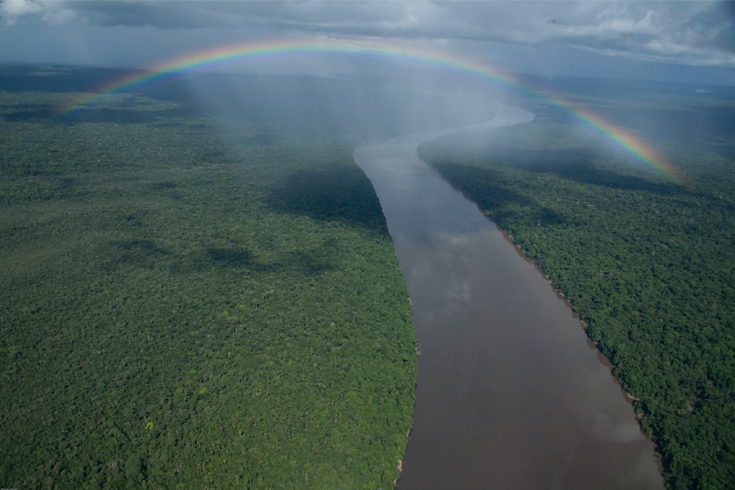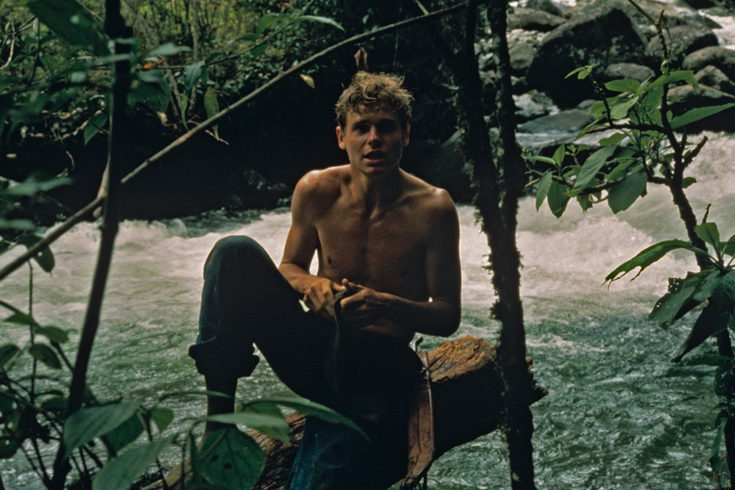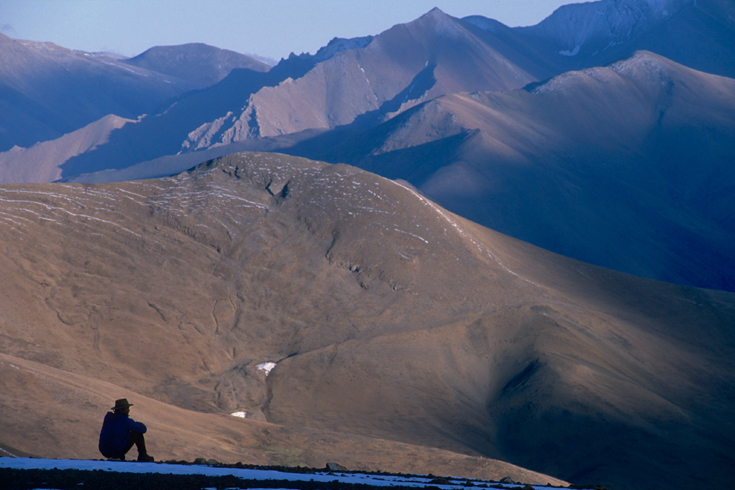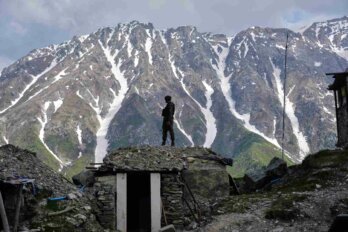“We shall not cease from exploration and the end of all our exploring will be to arrive where we started and know the place for the first time.”
—T. S. Eliot
Most of the Earth remains unexplored. We know more about the surface of the moon than we do about the floor of the ocean. We spend billions sending probes into space to seek evidence of water on Mars or ice on the moons of Jupiter while largely ignoring what lies below the seas that cover 70 percent of our blue planet. This is the deep unknown, the last frontier for marine explorers like Sylvia Earle and Jim Cameron, ocean depths that no human has seen or experienced.
On land, it’s another story and always has been, with the noted exception of Antarctica. The true and original explorers, men and women who actually went where no humans had been, were those who walked out of Africa some 65,000 years ago, embarking on a journey that, over 2,500 generations, roughly 40,000 years, carried the human spirit to every corner of the habitable world.
Since then, terrestrial exploration has rarely been divorced from power and conquest. Searching for a passage to the Indies, Jacques Cartier is said to have discovered the Saint Lawrence River in 1534, though the valley was clearly settled at the time, the waters offshore crowded with the Basque fleet, fishermen with no interest whatsoever in flaunting the location of their discoveries: a cod fishery that would feed Europe for three centuries.
History heralds Francisco de Orellana as the first to travel the length of the Amazon (1541), a journey documented by his companion and scribe, Gaspar de Carvajal, who wrote of fleets of native canoes and riverbanks dense with settlements, home to just some of the 10 million people then living in the basin.
In one of the stranger episodes of the Spanish conquest, expeditions led by Gonzalo Jiménez de Quesada, Sebastián de Belalcázar, and Nicolás Federmann, coming from the north, south, and east, all reached the savannah of Bogotá. At a hastily assembled parlay, the three explorers agreed to sail immediately for Spain so that their king, Charles V, might determine who among them was the official discoverer of a place, roughly the size of Belgium, that was the domain of over a million Muisca.
Such conceits and contradictions coloured the entire history of European exploration. When James Cook, arguably the finest navigator in the history of the Royal Navy, landed in Hawaii, his flagship was met by a flotilla of 3,000 native canoes. At Tonga, he observed that local catamarans could cover three leagues in the time it took his ship to achieve two. He encountered men from the Marquesas who could understand the language of Tahitians, though nearly a thousand miles separated these islands. On his very first voyage, in 1769, he met, in Tahiti, a navigator and priest, Tupaia, who drew a map from memory of every major island group in Polynesia, save Hawaii and Aotearoa. More than 120 stones were placed in the sand, each a symbol of an island across a span of more than 4,000 kilometres, from the Marquesas in the east to Fiji in the west, a distance equal to the width of the continental United States. Tupaia later sailed with Cook from Tahiti to New Zealand, a circuitous journey of nearly 12,875 kilometres that ranged between 48 degrees south latitude and 4 degrees north. To his astonishment, Cook reported, the Polynesian navigator was able to indicate, at every moment of the voyage, the precise direction back to Tahiti, though he had neither benefit of sextant nor knowledge of charts.
Cook and his naturalist, Joseph Banks, both of whom learned Tahitian, recognized the obvious cultural connections between the distant islands of Polynesia. They were convinced that the settling of the Pacific had occurred from the west, yet neither man could accept that these journeys had been feats of discovery and settlement as purposeful and deliberate as their own much celebrated explorations.
The twentieth century brought more of the same. Hiram Bingham shot to international fame and a place in the United States Senate with his discovery of Machu Picchu, an Incan site well known at the time to local farmers, who had told him where it was and how to get there. In 1921, George Mallory and his climbing companions walked off the map to find Everest, a mountain no one had approached at close quarters, save for the countless Tibetans they encountered as they trudged 644 kilometres across the plateau. Their arrival at Rongbuk, at the base of the mountain, made little impression. The Lama, Dzatrul Rinpoche, declined to break his retreat to greet them. In his namthar, a meticulous record of the spiritual and social life of the monastery, the arrival of the subsequent expedition in 1922 earns but a few lines, including: “I felt great compassion for them to suffer so much for such meaningless work.” Climbing to heights where oxygen deprivation obliterates consciousness, courting death, and placing at risk a precious incarnation and all its potential for spiritual transcendence was, from the Buddhist perspective, an act of pure folly.

In the 1870s, Arctic exploration took a fateful turn from the practical and nautical to the personal and ultimately meaningless as men from several nations set their sights on the North Pole, a point on the ice with no intrinsic significance save as an emblem of physical achievement and national will. In many ways, this was the beginning of what would become, in the twenty-first century, an entire industry of adventure. Reaching the North Pole was less a journey of discovery than it was a quest for personal glory and fame. Men such as Frederick Cook and Robert Peary clung desperately to their claims, often demonstrably false, even as they branded their expeditions indelibly with themselves. With endorsements, sponsorships, book deals, and lecture tours in mind, Robert Peary expunged his indispensable companion, Matthew Hensen, deliberately distancing himself from any association with an African American; the four Inuk men who accompanied them both to the pole remain little-known footnotes to the story.
In 1897, twelve years before reaching the pole, Robert Peary kidnapped an Inuit family, including a young boy named Minik, and brought them to New York as living specimens. Minik’s father soon died, and the boy was put into the care of a staff member of the American Museum of Natural History. It was there that he came upon the skeletons of his father and the others on display in a diorama. Minik survived twelve miserable years in the United States. In 1909, he begged Peary to take him home, but the famous explorer refused. By the time Minik finally returned to the Arctic, he was destitute, broken in body and spirit, lost between worlds, incapable of speaking his language, and unable to support himself as a hunter.
Back in Greenland, Minik came into the care of the greatest Arctic explorer of all time: Knud Rasmussen. In character, heart, motivation, and vision, Rasmussen was everything that Peary was not. What he achieved in a life cut short—he would die at fifty-four, having eaten an Inuk delicacy tainted with salmonella—a man of Peary’s ilk could neither appreciate nor understand. An enamelled faith in the superiority of his own culture left Peary half-blind, even as he stumbled north to the pole.
Rasmussen, by contrast, the son of a Danish missionary and a mother of Inuit blood, moved effortlessly between social and cultural realms, slipping in and out of role with ease, garnering respect and affection in all that he did and at every hunting camp and settlement he graced. Not to mention the literary salons and theatres of Copenhagen and Paris, where, at the height of his fame as a writer, his star shone so brightly that guards had to be posted at every door to keep his female admirers at bay. Such notoriety came only after a lifetime of exploration and achievement; Rasmussen neither sought attention nor made much of it. What mattered to him was the Arctic and the story of a people who had found a way to survive in such a land.
Raised among the Inughuit in Greenland, knowing their language from birth, running his own dogs by the age of nine, Rasmussen could and did live as a native. He thought nothing of slipping naked beneath caribou hides to share his body heat with an Elder. Like the Inuit, he didn’t fear the cold; he made use of it. A moist skin left overnight was a shovel by dawn. A hardened tool could be forged from human excrement. The runners of sleds were originally made from fish: three Arctic char laid in a row, wrapped in caribou hide and coated with a thin film of ice. A sled could be made from the carcass of a caribou, with runners made of rolled caribou skin and crossbars of frozen char and walrus meat cut to the right size. If things got tough, as Rasmussen once quipped, you could always eat your sled.
From an outpost at Thule, in remote northwest Greenland, Rasmussen and Peter Freuchan, his partner in exploration, launched seven research expeditions between 1912 and 1933, all epic in scale, which explored the length and breadth of Greenland and much of the eastern Canadian Arctic. Their most ambitious effort, the Fifth Thule Expedition, consumed four years as they travelled overland from northern Greenland to the western limits of Alaska and the Bering Sea, 32,187 kilometres altogether, all by dog team and sled. Nothing like it had been done in North America since Lewis and Clark.
Rasmussen did not undertake such journeys with endurance records in mind. He had no interest in being the first to do anything; his ambitions had nothing to do with the self. Given a choice, he preferred “hardship to boredom, danger and exposure to inactivity, the knife blade of hunger to the dull satisfaction of gluttony.” But, like the Inuit, he never sought adventure or courted death. Rasmussen laughed in the face of starvation and confronted tragedy with fatalistic indifference simply because, in the Arctic, there was no other way. Death and privation were everyday events.
Rasmussen’s holy grail was not an object or a place but a state of mind, a depth of understanding that would allow him to reveal to the world the wonder of Inuit life. Stretching across the circumpolar expanses was a common culture of the northern ice: people speaking dialects of the same language, sharing beliefs and myths, responding to the same adaptive imperatives. Only one who had crossed a continent could report, as Rasmussen did, that a youth in Greenland would recognize a tale told by a grandfather on the northern slope of Alaska, just as that Elder would know the folklore of the Inughuit of northwest Greenland.
Though a child of the Arctic, an adopted son of the Inuit, Rasmussen never abandoned his fidelity to Denmark or his obligations, as a writer and scholar, to record his observations. The research contributions of the Fifth Thule Expedition, published in 1946, fill no fewer than ten volumes, 6,000 pages altogether, with separate monographs dedicated to natural history, archaeology, linguistics, and ethnography, along with photographs of some 20,000 artifacts. These reports remain, to this day, a definitive source, offering an invaluable portrait of the Inuit before sustained and corrosive contact in the 1950s transformed their lives.
With his wizardly gift for languages and well-honed ethnographic eye, Rasmussen never doubted that the true glory of the Arctic resided in the genius and vision of the Inuit. His life’s mission was to know the world as they did, to understand the patterns of their lives, to enter their realms of magic and shamanic power. With knowledge as his goal, cultural understanding his quest, Rasmussen completely redefined the promise and potential of exploration not only in the Arctic but throughout all the far reaches of the inhabited world.
If Knud Rasmussen represents a certain ideal, a scholar of undaunted courage, a life of commitment and authenticity, the other end of the spectrum is occupied by colourful characters like my old friend, the late Sebastian Snow, a sometime journalist eulogized in the British press as “an eccentric explorer . . . the last of the gentleman adventurers.” Sebastian comes to mind whenever I hear of someone rowing a skiff across the Atlantic, base-jumping from some impossible height, or dying on the Northeast Ridge of Everest while waiting in queue to attempt the Second Step.
Sebastian and I met in Medellín, in 1974, as he reached the city having walked the length of South America from Tierra del Fuego. His goal was Alaska. As a boy, Sebastian broke his thigh playing rugby at Eton, and doctors said he’d never walk again. His life’s mission was to prove them wrong.
At twenty-one, Sebastian followed the Amazon River from source to mouth, a journey made possible only by those hired along the way, local guides who did the heavy lifting and generally kept him alive. His first book, My Amazon Adventure, includes a foreword by General E. F. Norton, Mallory’s close companion and the leader of the 1924 Everest Expedition. Recalling his own experience with porters in Tibet, Norton goes out of his way to downplay the role of Sebastian’s native companions, a disclaimer that speaks to a core conceit. “Without the driving power of the European,” Norton writes, “these feats are not within the scope of local talent.”
This was certainly true, but it was hardly an issue of character or the triumph of British pluck. The locals simply had other priorities in their lives and, from their point of view, better ways of spending their days.
By the time we met, Sebastian was forty-five, exhausted and well worn, having walked over 14,000 kilometres in eleven months. My job was to lead him through the Darien Gap, a notorious stretch of rainforest and swamp that separates Colombia from Panama, the one roadless passage on his intercontinental itinerary. The role fell somewhere between companion and “local talent.” I hardly qualified as a guide, for I knew little about where we were going, which didn’t concern Sebastian in the slightest. He courted trouble just as he cultivated eccentricity, if only as fodder for his books.

Sebastian’s long walk had been sponsored by a British newspaper, and his only obligation was to write periodic dispatches for a column that appeared on an irregular basis. Just what he had to say in these reports was something of a mystery. In eleven months, he had never strayed from the tarmac of the Pan-American Highway. In Ecuador, he had been joined by his old friend, the legendary British climber Chris Bonington. After a day, Bonington took to the hills, walking cross-country to relieve the boredom.
Sebastian spoke no Spanish and made no effort to pick up the language. If you speak the Queen’s English loud enough, he claimed, anyone will understand. He lived by this adage, which was amusing but didn’t inspire confidence that anything meaningful had been learned during his mostly solitary year on the road. The book that ultimately emerged from his adventure, The Rucksack Man, features a breezy introduction by well-known travel writer Eric Newby, another of Sebastian’s friends. Newby’s contribution, a tongue-in-cheek send up of Sebastian, is as substantive as any passage in the book.
Toward the end of our time together, Sebastian and I met an American engineer in Panama who asked why he had bothered to spend a year walking north on a highway. Sebastian, in a rare moment of reflection, described his journey as “an ongoingness into a neverendingness.” The American didn’t buy it. “Seems to me”, he quipped, “more like going from nowhere to nowhere and seeing how long it takes you.”
Hemingway said that the most important credential for a writer is to have something to say that the world needs to hear. Sebastian was a good man, but he failed this test as a writer. He had followed a highway the length of a continent while learning almost nothing of the people or the lands through which he’d moved. After so much effort, the story of his final journey, for sadly it would be the last, is distilled in a series of self-deprecating anecdotes that function largely to keep the narrative focused on the traveller, not the place. French anthropologist Claude Levi-Strauss famously dismissed the entire genre of travel literature as nothing but “grocery lists and lost dog stories” before going on to write perhaps the best travel book of all time, Tristes Tropiques. Still, he had a point.
Disregarded in its day and now long forgotten, The Rucksack Man, to be fair, was not the product of literary ambitions. Sebastian’s genre was the Englishman out of his element, a perfect frame for his misadventures, recounted in his inimitable way. At twenty, I’d never been a character in a book, and Sebastian could not have been more generous. Though I struggled to recognize myself in the stalwart companion he described, I certainly saw in his description a person I aspired to be.
With the publication of The Rucksack Man, my writing appeared in print for the first time, albeit passages from a journal that Sebastian had lifted and passed off as his own, which seemed at the time a fair exchange. He obtained some much-needed content while I saw my words alongside his, entire paragraphs, a juxtaposition that left me confident that, if this mad but endearing Englishman could write books, so, too, could I. Only books, I promised in a flush of pride and purpose, that would have something to say, informed by original research, not xeroxing, written and not simply typed; a lesson learned from The Rucksack Man, perhaps to a fault.
This obsession with content reached an extreme with Into the Silence, a story of Everest and the Great War, which took twelve years to complete. During the research phase, I purchased and studied 600 books relevant to the story, consulted fifty-seven archives in six countries, and made several extended trips to Tibet and Nepal. After a month together in the Kama Valley, Dorjee Lhatoo, who had trained many of India’s finest climbers as head of the Himalayan Mountaineering Institute, in Darjeeling, deemed me ready, both physically and mentally, to have a go at Everest. Though tempted, I declined, knowing that such a dramatic turn, difficult to ignore, might thrust me into the narrative in ways that would betray the book.
For my latest book, Magdalena: River of Dreams, I came to know the river, the Mississippi of Colombia, in all its dimensions, in all months of the year, with every shift of the seasons, from the headwaters in the Macizo Colombiano to the sand and stones of the Caribbean shore. At no point, however, was I tempted to paddle the Magdalena from source to mouth or to travel its length in a single journey, hitching rides perhaps on a series of barges and river boats. My goal was not to produce a study of self, an account of a personal journey; it was to write a biography of Colombia through the metaphor of the river that made possible the nation. When in doubt, an author should always get out of the way. Building a narrative around self is to travel writing what false heroics are to exploration.
In the fifth century BCE, the Greek historian Herodotus explored the length of the known world. Upon his return to Greece, he recounted a story from the Persian court, a morning when the emperor, Darius, gathered representatives of two of his subject peoples, one a culture that cremated their dead and the other a people that reputedly ate their dead. Darius asked each whether they might consider emulating the death rituals of the other. Both expressed horror at the thought.
Herodotus concluded from this the obvious: every culture favours its own traditions and looks down upon those of any other. Five centuries before Christ, this astute observer discerned the trait that, more than any other, has haunted humanity since the dawn of awareness: cultural myopia, the idea that our way is the right way and everyone else is a failure to be us, even if they don’t know it.
Herodotus observed but did not judge. This is what made him so remarkable—and so vilified by his contemporaries. Plato accused him of sympathizing with barbarians and urged that he be banished from Athens for celebrating the savages and, in doing so, betraying his own people. Herodotus might well have avoided Plato’s wrath had he simply recounted what he had eaten for breakfast, the names of the horses that had carried his kit, or how long it had taken to swim a river previously unknown to the Greeks and thus newly discovered by him.
Happily for history, Herodotus recorded instead what he learned, phenomena that had nothing to do with his personal experience; what he saw beyond the shadow of self; the beauty of the land, the strange creatures of the marshes, the poetry of the people. He travelled as a sage, eyes wide open to wonder. His explorations took him beyond the exotic into new realms of knowledge and belief, the spiritual home of the curious, the limitless horizons of the human imagination as brought into being by culture.
At the very dawn of Western civilization, Herodotus recognized the human legacy as the subject most worthy of his explorations. Two thousand years later, Knud Rasmussen acknowledged the Inuit as the avatars of the Arctic. In a well-trodden world, new generations of explorers could do far worse than emulate their examples.
An abridged version of this essay originally ran in the Financial Times.





